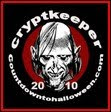This part 1 is a critique of the 1984 original. Part 2 to follow will examine the remake.
There are three major icons of the 20th century: Dracula, Frankenstein and the werewolf. Bram Stoker’s novel Dracula[1] was published in 1897. The 1931 film[2] starring Bela Lugosi is horror. Today Dracula - or versions of him - can be seen in the Twilight films (described as romantic fantasy). Mary Shelly’s Frankenstein 1st edition was published in 1818. The movie that rewrote the monster’s appearance starred Boris Karloff and was also released in 1931. It is one of the best horror films ever made. Frankenstein hasn’t been seen since Kenneth Brannagh’s 1994 melodrama. The Wolf Man 1941 starring Lon Chaney was a success. The Wolfman 2010 was not.
It is time for new icons.
A new breed of horror germinated with Night of the Living Dead 1968. This horror was not philosophical. It was societal. It was immediate. It was The Last House on the Left 1972. It was The Texas Elm Street
Dracula predates Stoker’s novel. The werewolf too is folklore. Shelly’s book is 200 years old. As seen with the Twilight saga and The Wolfman these icons are enduring. They will be revived throughout this century. The new icons’ durability has not yet been fully tested. The wave of first re-imaginings may already be over[3][4].
A Nightmare on Elm Street 2010 is tipping point.
don’t fall asleep
Wes Craven’s film takes surrealism and frames it within literal context. Everybody dreams. Human beings have an innate fear of the dark. It gets dark every time we close our eyes and we are at our most vulnerable when we sleep. In what could be a cinematic first and only every human being on this planet past present and future can relate to the concept of this film. If not for its inspiration[5] this would be ingenious. It remains brilliant.
Halloween had Jamie Lee Curtis. A Nightmare on Elm Street mimicked Janet Leigh. The shower scene in Psycho 1960 is doubly shocking: hero – dead. The unlikeable Tina’s death was momentarily off-balancing: she was the only one wise to the killer. It was momentary because Nancy Thompson immediately fills the lead role.
Tina is unsympathetic as written because she commits the cinema sin of cliché. She yields to the killer’s summons only to flee to her deathbed.
In the documentary Never Sleep Again 2006[6] – not to be confused with the incoming Never Sleep Again: The Elm Street Legacy 2010[7] – Craven says he wanted to cast someone intelligent looking to play Nancy Nancy
At the time of filming in 1984 the early 80s recession was fresh in memory. The Cold War was on the brink of Star Wars[7.5], college fees were escalating[8] and divorce was epidemic[9]. The white picket fence was stained. Nancy
By contrast Glen has two parents and is least prepared to deal with the bizarre. He denies his dreams. He ignores them and he dies in them. Admittedly Johnny Depp’s character is the least developed but he showed no sign of the star he was to become. He’s remembered in this film for his death scene. Craven cast him because his daughter thought he was cute[6].
Jessica Craven in New Nightmare
Freddy Krueger is a mesmerising villain complete with backstory and motivation. As innovative as the film’s concept is it is the relationship between him and Nancy that transcends this story into mythos[10]. That relationship is powered by the performance of Langenkamp. It is the Final Girl’s[11] role to seduce the audience into empathy. It is her point of view that will display the enormity of the evil in pursuit. Jamie Lee achieves that in Halloween. Langenkamp surpasses her in A Nightmare on Elm Street.
Langenkamp achieved a father-daughter presence with John Saxon that continued in Dream Warriors 1987 and New Nightmare 1994. She convinced as a good daughter who challenged her mother Ronne Blakley. As a girlfriend she was prim but not prude. She risked her life for her friends.
For the most part Krueger is an enigma in this film and this is how it should be. He lives in dreams and darts out of shadows. This demon has a very human quality of mirth. He enjoys the helplessness of Nancy
I could be bounded in a nutshell, and count myself a king of infinite space, were it not that I have bad dreams.
- William Shakespeare [Hamlet]
The dreamscape played as major set pieces in the sequels. In this original, apart from Nancy Nancy Nancy
Freddy’s legacy is indisputable. This is the first film that New Line Cinema produced. It spawned a franchise that built the studio[13]. It started a sub-genre. It is my assertion that Koji Suzuki was inspired by Elm Street Japan
Badly.
A Nightmare on Elm Street is one of the best horror films ever made.
Generated By Technorati Tag Generator














